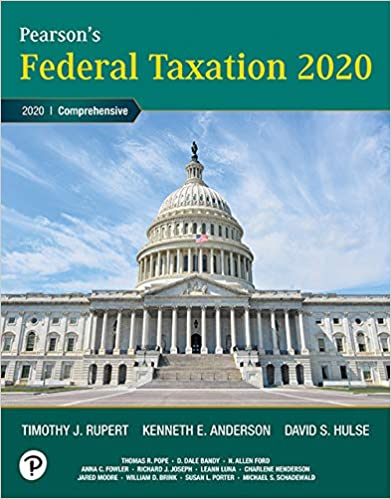Melodic Musical Sales, Inc. is located at 5500 Fourth Avenue, City, and ST 98765. The corporation uses
Question:
Estimated Tax Payments (Form 2220):
The corporation deposited estimated tax payments as follows:
April 15, 2013...........................................$120,000
June 17, 2013..............................................241,000
September 16, 2013.....................................290,000
December 16, 2013 Total........290,000.....$941,000
Some dates are the 16th or 17th because the 15th falls on a weekend or holiday.
Taxable income in 2012 was $1.2 million, and the 2012 tax was $408,000. The corporation
TABLE C: 3-4
Melodic Musical Sales, Inc.-Book Balance Sheet Information
-1.png)
-2.png)
-3.png)
-4.png)
-5.png)
Earned its 2013 taxable income evenly throughout the year. Therefore, it does not use the animalization or seasonal methods.
Inventory and Cost of Goods Sold (Form 1125-A):
The corporation uses the periodic inventory method and prices its inventory using the lower of FIFO cost or market. Only beginning inventory, ending inventory, and purchases should be reflected on Form 1125-A. No other costs or expenses are allocated to cost of goods sold. Note: the corporation is exempt from the uniform capitalization (UNICAP) rules because average gross income for the previous three years was less than 510 million.
Line 9 (a).......................check ii
(b), (c) & (d)........not applicable
(e) & (f)..................................no
Compensation of Officers (form 1125-E)
-6.png)
-7.png)
Bad Debts:
For tax purposes, the corporation uses the direct write off method of deducting bad debts. For book purposes, the corporation uses an allowance for doubtful accounts. During 2013, the corporation charged $39,200 to the allowance account, such amount representing actual write offs for 2013.
TABLE C: 3-5
Melodic Musical Sales, Inc.-Book Income Statement 2013
-8.png)
-9.png)
-10.png)
-11.png)
-12.png)
-13.png)
-14.png)
-15.png)
-16.png)
Additional information (schedule K);
-17.png)
-18.png)
-19.png)
-20.png)
Organizational Expenditures:
The corporation incurred $14,000 of organizational expenditures on January 2, 2009. For book purposes, the corporation expensed the entire expenditure. For tax purposes, the corporation elected under Sec. 248 to deduct $5,000 in 2010 and amortize the remaining $9,000 amount over 180 months, with a full month's amortization taken for January 2010. The corporation reports this amortization in Part VI of Form 4562 and includes it in "Other Deductions" on Form 1120, Line 26.
Capital Gains and Losses:
The corporation sold 100 shares of PDQ Corp. common stock on October 8, 2013, for $200,000. The corporation acquired the stock on December 15, 2012, for $140,000. The corporation also sold 75 shares of JSB Corp. common stock on June 18, 2013, for $168,000. The corporation acquired this stock on September 18, 2011, for $180,000. The corporation has a $15,000 capital loss carryover from 2012.
Fixed Assets and Depreciation:
For book purposes: The corporation uses straight-line depreciation over the useful lives of assets as follows: Store building, 50 years; Equipment, 15 years (old) and ten years (new); and Trucks, five years. The corporation takes a half-year's depreciation in the year of acquisition and the year of disposition and assumes no salvage value. The book financial statements in Tables C: 3-4 and C:3-5 reflect these calculations.
For tax purposes:
All assets are MACRS property as follows: Store building, 39-year non-residential real property; equipment, seven-year property; and trucks, five-year property. The corporation acquired the store building for $2 million and placed it in service on January 2, 2010. The corporation acquired two pieces of equipment for $300,000 (Equipment 1) and $600,000 (Equipment 2) and placed them in service on January 2, 2010. The corporation acquired the trucks for $280,000 and placed them in service on July 18, 2011. The trucks are not listed property and are not subject to the limitation on luxury automobiles. The corporation did not make the expensing election under Sec. 179 or take bonus depreciation on any property acquired before 2013. Accumulated tax depreciation through December 31, 2012, on these properties is as follows:
Store building...................$151780
Equipment 1.......................168810
Equipment 2.......................337620
Trucks.................................145600
On October 16, 2013, the corporation sold for $320,000 Equipment 1 that originally cost 300,000 on January 2, 2010. The corporation had no Sec. 1231 losses from prior years. In a separate transaction on October 17, 2013, the corporation acquired and placed in service a piece of equipment costing $2.2 million. Assume these two transactions do not qualify as a like-kind exchange under Reg. Sec. 1.1031(k)-1(a). The new equipment is seven-year property. The corporation made the Sec, 179 expensing election with regard to the new equipment but elected out of bonus depreciation, where applicable, use published IRS depreciation tables to compute 2013 depreciation (reproduced in Appendix C of this text).
Other Information:
€¢ The corporation's activities do not qualify for the U.S. production activities deduction.
€¢ Ignore the AMT and accumulated earnings tax.
€¢ The corporation received dividends (see Income Statement in Table C: 3-5) from taxable, domestic corporations, the stock of which Melodic Musical Sales, Inc. owns less than 20%.
€¢ The corporation paid $98,000 in cash dividends to its shareholders during the year and charged the payment directly to retained earnings.
€¢ The state income tax in Table C: 3-5 is the exact amount of such taxes incurred during the year.
€¢ The corporation is not entitled any credits.
€¢ Ignore the financial statement impact of any underpayment penalties incurred on the tax return.
Required:
Prepare the 2013 corporate tax return for Melodic Musical Sales, Inc. along with any necessary supporting schedules.
Optional:
Prepare both Schedule M-3 (but omit Schedule 13) and Schedule M-1 even though the IRS does not require both Schedule M-1 and Schedule M-3.
The ending inventory is the amount of inventory that a business is required to present on its balance sheet. It can be calculated using the ending inventory formula Ending Inventory Formula =... Financial Statements
Financial statements are the standardized formats to present the financial information related to a business or an organization for its users. Financial statements contain the historical information as well as current period’s financial... Common Stock
Common stock is an equity component that represents the worth of stock owned by the shareholders of the company. The common stock represents the par value of the shares outstanding at a balance sheet date. Public companies can trade their stocks on... Salvage Value
Salvage value is the estimated book value of an asset after depreciation is complete, based on what a company expects to receive in exchange for the asset at the end of its useful life. As such, an asset’s estimated salvage value is an important... Balance Sheet
Balance sheet is a statement of the financial position of a business that list all the assets, liabilities, and owner’s equity and shareholder’s equity at a particular point of time. A balance sheet is also called as a “statement of financial... Corporation
A Corporation is a legal form of business that is separate from its owner. In other words, a corporation is a business or organization formed by a group of people, and its right and liabilities separate from those of the individuals involved. It may...
Step by Step Answer:

Federal Taxation 2020 Comprehensive
ISBN: 9780135196274
33rd Edition
Authors: Timothy J. Rupert, Kenneth E. Anderson, David S. Hulse





